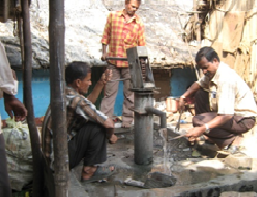
Clean surroundings, clean water and a clean toilet – as much as Cuttack, in Odisha is a thriving centre of trade and commerce, it lacked these three basic necessities. An exploratory survey was conducted in 2009 to understand why the city hadn't reached a better state of cleanliness. It found that 90% of the people followed open defecation, 99% threw garbage outside the house into open drains and canals and only 56% treated their drinking water.
People wished to better their environment, the government had resources & policies to bring about a change but only key ingredient was missing - 'good' governance.
This is when Health and Development Initiative (HDI), National Foundation of India (NFI) and Arghyam came together. Between July 2010 and June 2012, they implemented a project to create a community-based water management, sanitation and waste disposal system, where the locals managed these important issues. The organisations believed that only when a project became self sustainable only when it went from a feeling of 'theirs' to 'ours'.

The first step was community mobilization - or the process to involve the locals to make them aware of the project. They conducted Informal meetings and discussions that not only involved influential people but also those who were typically left out of such types of discussions such as young girls, differently abled people and widows.
To involve children, they conducted competitions and games around the topics of sanitation and health. After talking to a wide range of people, the organisations selected local leaders at all levels. During all this, they also carried out sessions on personal hygiene, awareness and the importance of clean drinking water including talks by doctors to drive the message home. Only once the locals had somewhat bought in to the idea, did the actual ground work on water, sanitation and health begin.

Defunct tubewells were made functional – people volunteered to provide manual labour – and new wells were dug after residents unanimously voted on their location. Existing water sources such as taps, stand posts were repaired. A pond near Swapneswar temple was renovated and people stopped defecating around it.
An old defunt community toilet was made functional after continuous follow up with the authorities by the local youth themselves. Its day to day operation and maintenance is now carried out by the community who has taken complete charge of its own asset!
On the sanitation front, individual toilets were built. A revolving fund has now been created to help finance families keen to construct toilets at their homes. To reduce garbage in the lanes, dustbins were distributed. As an incentive, basil plants (thulsi), considered holy by most, were distributed and people were encouraged to plant them. Rangolis (decorative drawings outside homes), were drawn to beautify the surroundings. Now there is no garbage thrown on the roads leaving the streets cleaner. Individuals step forward to sweep any trash off the streets and children don't defecate in the open either. Drains were also repaired through a joint effort with the community. Soak pits were made at places to absorb wastewater in the ground.

As people became more aware of their rights, they began to question why the municipal authorities did not extend such essential services as waste collection in their neighbourhood. A 'Grievance Committee' was formed in every sahi/ neighbourhood to address this, and today the same communities are discussing, prioritizing, identifying and finalizing issues that need to be raised to higher authorities.
Though there are a number of positive outcomes, there are still some issues that have to be sorted through.
- The newly formed peoples’ greivance committees aren't always recognised, especially outside the community. Government officals also sometimes do not accept their complaints and question their decision to speak for the entire community.
- Locals were reluctant to pay for services (like waste collection, cleaning etc) as they felt that it should be the responsibility of the municipality.
- The last concern was key - how long would this programme sustain once external help was withdrawn?
This project has nudged the community in the direction of 'self governance'. It has helped it plan, formulate & create its own system of working in a manner that includes the entire community. As the ownership of the community strengthens further, it can intensify its efforts to demand more and better quality services from the service-providing agencies, whether private or government.
/articles/more-people-power-equals-more-progress